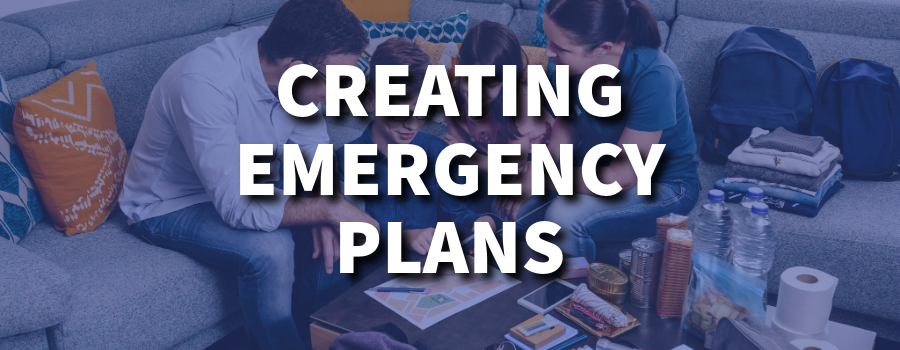Creating An Emergency Plan

While most people often think “it won’t happen to us,” the reality is that emergencies can strike anyone, anywhere, at any time. Whether it’s a natural disaster, a medical crisis or a widespread power outage, having a well-thought-out emergency plan can make all the difference in keeping your family safe. It is important for Idahoans to be prepared and take the time to create an emergency plan for their household of what to do, where to go, who to contact, and more in the event an emergency does happen.
What Are the Risks of Where You Live?
Before you create an emergency plan it is important to understand the specific risks that you and your community may face, whether it’s wildfires, floods, earthquakes, winter storms, or other natural hazards. It’s important to take these potential events into account by recognizing the warning signs, determining whether you would need to shelter in place or evacuate, and planning how to respond to the impact of these events.
Local emergency management offices may be able to help identify the hazards in your area and offer preparedness information. It may be helpful to also find out from local emergency managers how citizens can and will be notified in case of a disaster.
What Are the Specific Needs of Your Household?
Next, folks will want to consider the specific needs of their family and household. Tailor your plans and supplies to accommodate your daily living needs and responsibilities. It’s also a good idea to work with others to create networks of neighbors, relatives, friends, and co-workers who can assist each other in an emergency. Discuss your needs and responsibilities, and how people in your network can help with communication, childcare, business continuity, pet care, or operating medical equipment. Here are some key factors to consider when customizing your emergency plan:
- Different ages of household members
- Responsibilities for assisting others
- Locations frequented by family members
- Dietary needs
- Medical needs, including prescriptions and equipment
- Disabilities or access and functional needs, including devices and equipment
- Languages spoken
- Cultural and religious considerations
- Pets or service animals
- Households with school-aged children
What Are Your Plans for Places Outside Your Home?
While some emergencies come with warnings, many can happen suddenly and without advance notice. Since you can’t always predict where you’ll be during such events, it’s important to have plans and supplies ready for the different locations you and your household frequently visit. Consider places like workplaces, schools, and community centers. Learn more about the emergency plans at these locations and adapt your personal and household plans to reflect what each member should do if an emergency occurs while they are there.
Additionally, plan for the possibility that you and your family may be separated during an emergency. Choose two specific meeting places: one outside your home for immediate emergencies and another outside your neighborhood for evacuation situations. Designate an out-of-area emergency contact person—someone who lives far enough away that it’s easier to reach them if local phone lines are overloaded or out of service. Be sure that everyone carries this emergency contact information in writing and/or saved on their cell phones.
Create Your Emergency Plan
To start building an emergency plan, address these key questions with your family, friends, or household.
- Determine how you will receive emergency alerts and warnings. Whether through weather apps, local news, or emergency alert systems—to ensure you stay informed of potential threats.
- Establish your shelter plan. Identify safe locations within your home or community where you can take shelter during different types of emergencies, such as severe storms or a power outage.
- Map out your evacuation route. Be sure to include primary and secondary routes to safely leave your home and reach designated safe areas. Practice evacuating your home twice a year.
- Develop a family or household communication plan. Outline how you’ll stay in touch during an emergency, including a designated meeting spot and contact information for all family members.
- Create or update your emergency preparedness kit. Be sure it contains the essentials for your family’s needs, such as food, water, medications, and other critical supplies.
Utilize Ready.gov’s fillable Family Emergency Plan form to help you address some of these questions and create your own plan.
Regularly Review and Practice Your Plan
Creating an emergency plan is an important step in ensuring your family’s safety during unexpected events, but it doesn’t end with just having a plan in place. Be sure to regularly review and update your plan to accommodate any changes in your family’s needs, living situation, or local risks. Schedule periodic check-ins—at least twice a year—to reassess and adjust your plan as necessary. Additionally, practicing your emergency plan through regular drills helps ensure that everyone knows their roles and actions when an actual emergency occurs.
By staying proactive and keeping your plan current, you and your loved ones will be well-prepared to handle any situation that arises, no matter where you are.
For additional information to create an emergency plan, check out some of these resources:

